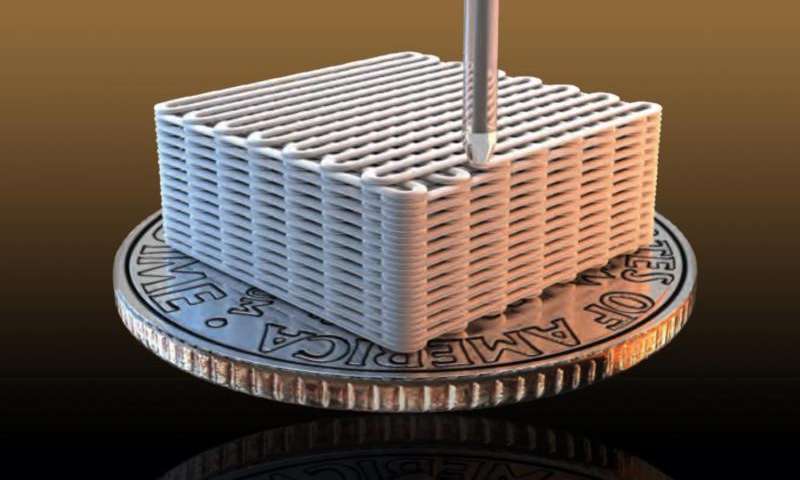 Researchers at the Lawrence Livermore National Laboratory (LLNL) are big fans of using 3D printing and that’s something for naysayers, growing few and far between these days, to note. From creating new materials in metal 3D printing to performing elaborate stress tests, as well as other major contributing projects like creating more standardized 3D printing software, we report on important LLNL news often.
Researchers at the Lawrence Livermore National Laboratory (LLNL) are big fans of using 3D printing and that’s something for naysayers, growing few and far between these days, to note. From creating new materials in metal 3D printing to performing elaborate stress tests, as well as other major contributing projects like creating more standardized 3D printing software, we report on important LLNL news often.
 Recently they’ve announced a new breakthrough with lightweight 3D printed graphene aerogels exhibiting super compressibility, offering up to 90 percent compressive strain. Aerogel, a solid lightweight component, also known as ‘liquid smoke,’ is interesting and unique in that the gel is replaced with gas. The aerogel component itself is one of the most lightweight solid materials available for use, and makes up a widely diversified range of components which seem to be almost weightless at 98.2% air. They are traditionally used in myriad ways and forms, from insulation to chemical agents and even drug delivery systems.
Recently they’ve announced a new breakthrough with lightweight 3D printed graphene aerogels exhibiting super compressibility, offering up to 90 percent compressive strain. Aerogel, a solid lightweight component, also known as ‘liquid smoke,’ is interesting and unique in that the gel is replaced with gas. The aerogel component itself is one of the most lightweight solid materials available for use, and makes up a widely diversified range of components which seem to be almost weightless at 98.2% air. They are traditionally used in myriad ways and forms, from insulation to chemical agents and even drug delivery systems.
Using direct ink writing in 3D printing, LLNL researchers have been able to engineer a transformative architecture that far outweighs traditional attempts of creating bulk graphene aerogels that produce ‘largely random pore structures’ unable to provide mechanical transport for items like sensors, flow batteries, and separations.
“Making graphene aerogels with tailored macro-architectures for specific applications with a controllable and scalable assembly method remains a significant challenge that we were able to tackle,” said engineer Marcus Worsley, a co-author of the research paper regarding the subject which appeared in the April 22 edition of Nature Communications.
“3D printing allows one to intelligently design the pore structure of the aerogel, permitting control over mass transport (aerogels typically require high pressure gradients to drive mass transport through them due to small, tortuous pore structure) and optimization of physical properties, such as stiffness. This development should open up the design space for using aerogels in novel and creative applications.”
 With the new process, inks composed of graphene oxide (GO) are used. Composed of aqueous GO suspension and silica filler, the inks are extruded through a micronozzle during 3D printing.
With the new process, inks composed of graphene oxide (GO) are used. Composed of aqueous GO suspension and silica filler, the inks are extruded through a micronozzle during 3D printing.
Through producing the graphene aerogel microlattices which offer excellent electrical conductivity and high surface area, new ways of storing energy are created, as well as being useful in:
“Adapting the 3D printing technique to aerogels makes it possible to fabricate countless complex aerogel architectures for applications such as mechanical properties and compressibility, which has never been achieved before,” said engineer Cheng Zhu, the other co-author of the journal article.
How do you think these 3D printed aerogels will be useful in the future? Could this process ultimately lead to batteries with higher energy densities? Tell us your thoughts in the 3D Printed Graphene Aerogel Microlattices forum over at 3DPB.com.
Subscribe to Our Email Newsletter
Stay up-to-date on all the latest news from the 3D printing industry and receive information and offers from third party vendors.
You May Also Like
Profiling a Construction 3D Printing Pioneer: US Army Corps of Engineers’ Megan Kreiger
The world of construction 3D printing is still so new that the true experts can probably be counted on two hands. Among them is Megan Kreiger, Portfolio Manager of Additive...
US Army Corps of Engineers Taps Lincoln Electric & Eaton for Largest 3D Printed US Civil Works Part
The Soo Locks sit on the US-Canadian border, enabling maritime travel between Lake Superior and Lake Huron, from which ships can reach the rest of the Great Lakes. Crafts carrying...
Construction 3D Printing CEO Reflects on Being Female in Construction
Natalie Wadley, CEO of ChangeMaker3D, could hear the words of her daughter sitting next to her resounding in her head. “Mum, MUM, you’ve won!” Wadley had just won the prestigious...
1Print to Commercialize 3D Printed Coastal Resilience Solutions
1Print, a company that specializes in deploying additive construction (AC) for infrastructure projects, has entered an agreement with the University of Miami (UM) to accelerate commercialization of the SEAHIVE shoreline...






























